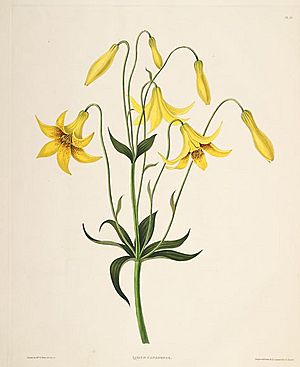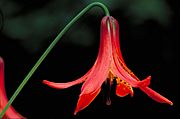Canada lily facts for kids
Quick facts for kids Canada lily |
|
|---|---|
 |
|
| Canada lily | |
| Scientific classification | |
| Genus: |
Lilium
|
| Species: |
canadense
|
| Synonyms | |
|
|
The Canada Lily (scientific name: Lilium canadense) is a beautiful wild flower. People also call it the wild yellow-lily or meadow lily. It grows naturally in eastern North America.
This plant is found from Ontario to Nova Scotia in Canada. In the United States, it grows south to Georgia and Alabama. You can often see it in New England, the Appalachian Mountains, and the Canadian Maritimes. Sometimes, people even grow it in gardens in Europe.
Contents
What is the Canada Lily?
The Canada Lily usually lives in wet fields and at the edges of forests. These plants can grow quite tall, from about 0.5 to 1.5 meters (about 1.5 to 5 feet).
Its flowers bloom in June and July. They are about 50–75 mm (2–3 inches) wide. The flowers hang downwards, which is called "nodding." They can be yellow, orange, or red, and often have darker spots.
Why is the Canada Lily Important?
Long ago, Native American peoples used the Canada Lily for food. They would gather and eat the flower buds and the roots of the plant.
Is the Canada Lily in Danger?
In some parts of the United States, the Canada Lily is becoming less common. It is listed as "Rare" in Indiana. In New York State, it is "Exploitably Vulnerable," meaning it could easily become endangered if too many are picked or disturbed. It is "Threatened" in Rhode Island and Tennessee.
One reason it is less common in cities and suburbs is because white-tailed deer like to eat it. This is called "browsing."
See also

- Flora of Canada
- Flora of the Eastern United States
- In Spanish: Lirio del prado para niños



